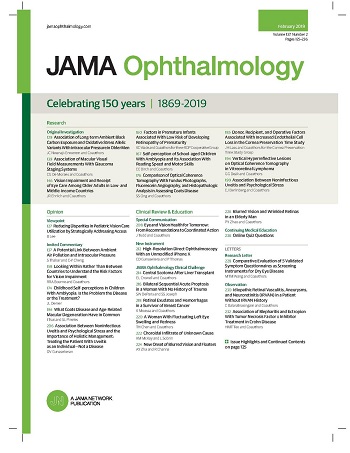大型县域安全网远程网膜筛检计划之急性闭角发生率。
IF 9.2
1区 医学
Q1 OPHTHALMOLOGY
引用次数: 0
摘要
药理学瞳孔扩张对眼病筛查至关重要,但由于担心引发急性闭角(AAC),这是一种威胁视力的眼科紧急情况,因此经常避免使用。目的评估扩张后AAC的发生率,验证国际疾病分类(ICD)编码识别AAC的有效性。设计、环境和参与者本回顾性队列研究使用了基于初级保健的远端视网膜糖尿病视网膜病变筛查(TDRS)项目的数据。符合条件的参与者是2013年8月23日至2024年3月1日期间接受扩张性眼底摄影远程视网膜筛查的洛杉矶县卫生服务部门患者。使用ICD闭角代码识别潜在AAC病例,包括AAC青光眼、原发性闭角青光眼和解剖性窄角,在扩张3个月内。还确定了TDRS后下一个日历天内的所有急诊、急诊科和眼科诊所就诊情况,以及TDRS后14个日历天内虹膜切除术/虹膜切除术或晶状体摘除术的现行程序术语代码。通过手工病历审核,验证AAC病例,提取临床信息。数据分析时间为2024年7月至2025年6月。暴露:用1%的纯品酰胺或0.5%的纯品酰胺进行扩张。扩张后AAC的累积发生率。结果84例 008例患者中,女性46 255例(55.1%),平均(SD)年龄为55.4(10.7)岁。共有168次 796次扩张,平均(SD)为2.01(1.50)次扩张。手工病历复习证实4例扩张后AAC,其中3例为AAC青光眼,1例为解剖窄角。AAC风险为每100 万例扩张2.4例(95% CI, 0.05-4.69)(0.002%)或每100 万例患者4.8例(95% CI, 0.10-9.43)(0.005%)。4例AAC均发生于女性患者,在阴道镜检查时未出现眼内角度狭窄,并在1天内出现AAC症状,包括眼痛和视力模糊。结论和相关性:在服务于多样化安全网人群的大容量TDRS项目中,每次扩张的aac风险小于1 / 40 000,支持在这种情况下扩张的总体安全性。进一步讨论AAC风险作为扩张禁忌症是有必要的。本文章由计算机程序翻译,如有差异,请以英文原文为准。
Acute Angle Closure Incidence in a Large Countywide Safety Net Teleretinal Screening Program.
Importance
Pharmacologic pupillary dilation is vital for eye disease screening but is often avoided due to concerns about triggering acute angle closure (AAC), a sight-threatening ophthalmic emergency.
Objective
To assess AAC incidence after dilation and validate the use of International Classification of Diseases (ICD) codes for identifying AAC cases.
Design, Setting, and Participants
This retrospective cohort study used data from a primary care-based teleretinal diabetic retinopathy screening (TDRS) program. Eligible participants were Los Angeles County Department of Health Services patients who underwent teleretinal screening by dilated fundus photography between August 23, 2013, and March 1, 2024. Potential AAC cases were identified using ICD codes for angle closure, including AAC glaucoma, primary angle-closure glaucoma, and anatomical narrow angle, within 3 months of dilation. All urgent care, emergency department, and eye clinic encounters within the next calendar day after TDRS and encounters with Current Procedural Terminology codes for iridectomy/iridotomy or lens extraction within 14 calendar days of TDRS were also identified. Manual medical record review was conducted to verify AAC cases and extract clinical information. Data were analyzed from July 2024 to June 2025.
Exposures
Dilation with tropicamide, 1.0%, or tropicamide, 0.5%.
Main Outcomes and Measures
Cumulative incidence of AAC after dilation.
Results
Of 84 008 included patients, 46 255 (55.1%) were female, and the mean (SD) age was 55.4 (10.7) years. There were a total of 168 796 dilations, with a mean (SD) of 2.01 (1.50) dilations per patient. Manual medical record review confirmed 4 AAC cases after dilation: 3 coded as AAC glaucoma and 1 as anatomical narrow angle. The AAC risk was 2.4 (95% CI, 0.05-4.69) per 100 000 dilations (0.002%) or 4.8 (95% CI, 0.10-9.43) per 100 000 patients (0.005%). All 4 AACs occurred in female patients, had narrow angles in the nonpresenting eye on gonioscopy, and presented within 1 day with AAC symptoms, including eye pain and blurry vision.
Conclusions and Relevance
AAC risk was less than 1 in 40 000 per dilation in a high-volume TDRS program serving a diverse safety net population, supporting the overall safety of dilation in this setting. Further discussion about AAC risk as a contraindication to dilation is warranted.
求助全文
通过发布文献求助,成功后即可免费获取论文全文。
去求助
来源期刊

JAMA ophthalmology
OPHTHALMOLOGY-
CiteScore
13.20
自引率
3.70%
发文量
340
期刊介绍:
JAMA Ophthalmology, with a rich history of continuous publication since 1869, stands as a distinguished international, peer-reviewed journal dedicated to ophthalmology and visual science. In 2019, the journal proudly commemorated 150 years of uninterrupted service to the field. As a member of the esteemed JAMA Network, a consortium renowned for its peer-reviewed general medical and specialty publications, JAMA Ophthalmology upholds the highest standards of excellence in disseminating cutting-edge research and insights. Join us in celebrating our legacy and advancing the frontiers of ophthalmology and visual science.
 求助内容:
求助内容: 应助结果提醒方式:
应助结果提醒方式:


